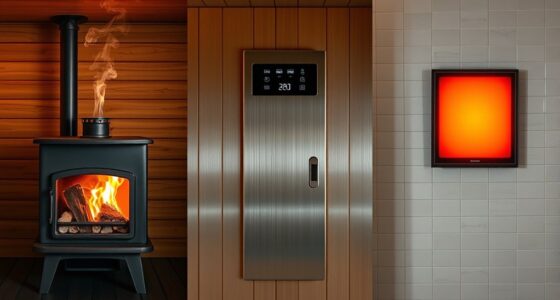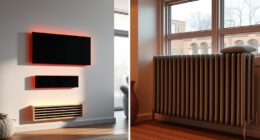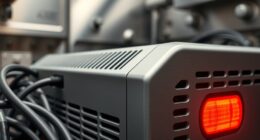If you’re exploring timers and thermostats, here’s a helpful overview: timers control power flow based on schedules, with mechanical and digital options, while thermostats regulate your home’s temperature using sensors, with traditional, digital, and smart types. Using programmable thermostats can save energy by adjusting settings automatically. Understanding the different types, functions, and maintenance tips guarantees peak performance. Continue exploring to discover how to troubleshoot common issues and maximize energy savings effectively.
Key Takeaways
- Timers control electrical circuits by switching power on or off based on scheduled settings, with mechanical and digital types available.
- Thermostats regulate indoor temperature through sensors, with manual, digital, and smart models offering varying control features.
- Digital timers and thermostats provide preset schedules, remote operation, and better integration with modern smart home systems.
- Proper setup, regular calibration, and maintenance optimize energy savings and prolong device lifespan.
- Troubleshooting involves checking power sources, wiring, batteries, and consulting professionals for persistent issues.
What Is a Timer and How Does It Work?

Ever wondered how timers automatically turn devices on or off at set times? Timers are simple devices that control power flow based on a schedule you program. They work by switching electrical circuits on or off at specific intervals, making them ideal for energy savings and automation. Proper timer maintenance ensures they keep functioning accurately, preventing unexpected shutdowns or failures. When installing a thermostat, understanding timers helps you integrate automatic control with heating or cooling systems effectively. Some timers are programmable, allowing you to customize ON/OFF times, while others are mechanical. Regularly checking and maintaining your timers guarantees reliable operation, especially when used alongside thermostat installation. This synergy helps you manage your device schedules effortlessly, saving energy and enhancing convenience. Incorporating automation technology into your system can further optimize efficiency and user experience.
Understanding Thermostats: Types and Functions

Thermostats come in various types, each designed to suit different heating and cooling needs. Understanding how they work helps you choose the right one for your home. Let’s explore the main types and their functions to make informed decisions. A textile line can also be incorporated into smart thermostat designs to enhance their aesthetic appeal and user interface.
Types of Thermostats
Are you familiar with the different types of thermostats available for your home? There are several options, each offering unique features to suit your needs. Traditional thermostats are simple and manual, adjusting temperature with a dial or buttons. Digital thermostats provide more precise control and can display current settings clearly. Smart home thermostats connect to Wi-Fi, allowing you to control your heating and cooling remotely via your smartphone. These smart devices often learn your habits, optimizing energy efficiency and reducing utility costs. Programmable thermostats enable you to set schedules to match your daily routine, saving energy when you’re away or asleep. Automation technologies are increasingly integrated into thermostats to enhance convenience and energy management. Choosing the right type depends on your preferences, budget, and desire for convenience or advanced features.
How Thermostats Work
Understanding how thermostats work involves knowing their main function: regulating your home’s temperature. They detect temperature changes using sensors and activate heating or cooling systems accordingly. To achieve this, thermostats rely on precise sensor calibration to ensure accurate readings. Some models include humidity control features, which maintain comfort by adjusting moisture levels. Additionally, incorporating sound therapy science elements into smart thermostat designs could enhance user relaxation experiences.
Imagine this setup:
| Temperature Sensor | Humidity Sensor |
|---|---|
| Detects heat levels | Monitors moisture |
| Sends signals to HVAC | Adjusts humidity |
This imagery helps you picture how sensors work together to keep your home comfortable. By understanding sensor calibration and humidity control, you can better appreciate how thermostats maintain consistent indoor conditions efficiently.
Difference Between Mechanical and Digital Timers
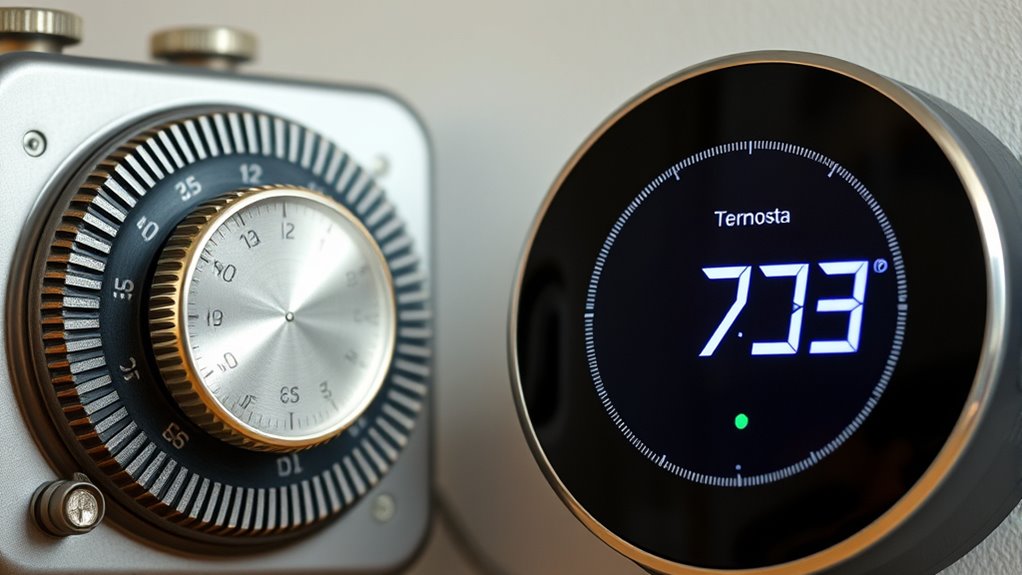
Mechanical timers operate with simple gears and manual settings, while digital timers use electronic displays and precise controls. You’ll find digital models easier to program and adjust, with features like preset schedules. Mechanical timers, on the other hand, are more straightforward but may require more manual work. Additionally, understanding survivalist equipment can help you choose timers suitable for off-grid or emergency use scenarios.
Mechanical vs. Digital Operation
While both mechanical and digital timers serve the same basic purpose of controlling devices on a schedule, they operate in distinctly different ways. Mechanical timers use analog controls like dials and switches, relying on gears and springs to keep time. Their user interface is simple, often featuring physical knobs for setting programs. Digital timers, however, use electronic components, offering a more advanced user interface with buttons and screens. They can store multiple schedules and adjust settings easily. Additionally, digital timers often incorporate advanced features such as programmable settings and remote control capabilities.
Ease of Use Differences
When choosing between mechanical and digital timers, ease of use plays a significant role. Digital timers often feature a user-friendly interface with buttons and displays that simplify setting schedules. Mechanical timers, on the other hand, rely on dials and pins, which can be less intuitive. Installation ease also varies: digital models typically have straightforward setups, while mechanical timers may require more manual adjustments. Here’s a quick comparison:
| Feature | Mechanical Timer | Digital Timer | Ease of Use |
|---|---|---|---|
| User Interface | Dials and pins | Buttons and screens | Digital timers are generally more user-friendly |
| Setup Process | Manual adjustments | Plug-and-play setup | Digital timers usually install faster |
| Precision | Less precise | Highly precise | Digital timers offer better scheduling control |
Additionally, digital timers may be more compatible with AI-powered smart home systems, enhancing convenience and automation.
How Do Programmable Thermostats Save Energy?
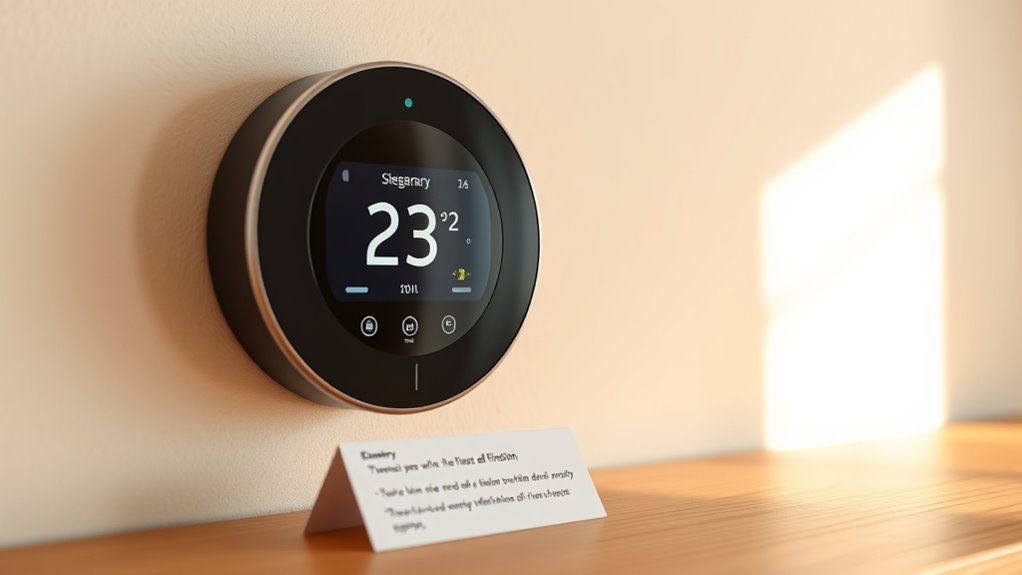
Programmable thermostats save energy by allowing you to set specific temperatures for different times of the day, reducing unnecessary heating or cooling when you’re not home or during sleep. This helps you avoid wasting energy on maintaining constant temperatures. By implementing a programmable schedule, you can optimize comfort while minimizing energy consumption. Additionally, noise levels of modern heat pumps have become quieter, making them less disruptive during operation. Here are some key benefits: – Maximize energy conservation tips by customizing temperature settings – Reduce utility bills with efficient climate control – Avoid overheating or overcooling during unoccupied periods – Improve overall energy efficiency of your home Using these features, you not only save money but also contribute to environmental preservation. The programmable schedule benefits are clear: smarter energy use leads to lower costs and less waste, making your home more eco-friendly.
Common Terms Associated With Temperature Control Devices
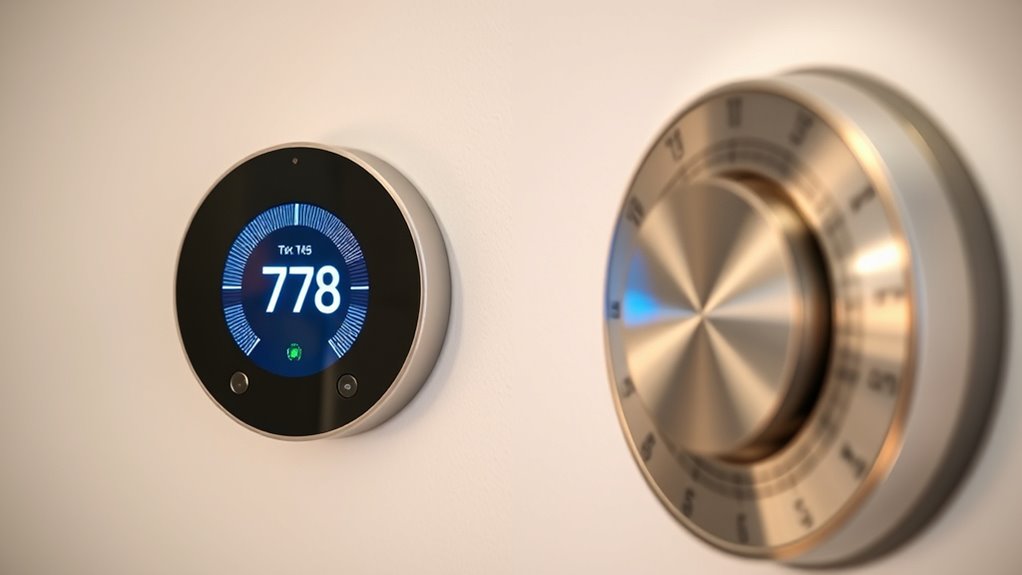
Are you familiar with the key terms used in temperature control devices? Understanding common terms helps you operate and troubleshoot your equipment effectively. Sensor calibration refers to adjusting the sensor to guarantee accurate temperature readings, preventing false triggers or ineffective control. Power supply components are essential parts that provide the necessary voltage and current to keep your thermostat or timer functioning properly. These components include transformers, batteries, or power adapters, depending on the device. Proper calibration and reliable power supply components ensure your device maintains precise temperature control and operates consistently. Recognizing these terms allows you to better understand how your system works and identify issues early, enhancing both efficiency and longevity of your temperature control devices. Additionally, familiarity with appliance testing techniques can help ensure safety and proper functioning of your devices.
Setting and Adjusting Your Timer and Thermostat

To effectively manage your temperature control devices, you need to know how to set and adjust your timer and thermostat. Proper setup ensures ideal comfort and energy efficiency. Start by reviewing the installation considerations to guarantee your devices are correctly installed for easy adjustments. When setting your timer, input your desired schedule, considering maintenance tips like regular battery checks. Adjust your thermostat settings based on your daily routine to save energy and maintain comfort. Remember, a well-calibrated thermostat prevents unnecessary wear on your HVAC system. Keep your devices clean and free of dust, and periodically verify the settings to avoid surprises. These simple steps will help you maximize your device’s performance and longevity. Regularly energy efficiency evaluations can also help identify additional ways to optimize your home’s climate control systems.
Troubleshooting Basic Issues With Timers and Thermostats

When your timer or thermostat isn’t working properly, troubleshooting begins with checking the power supply and making sure the devices are receiving power. Start by inspecting the batteries; if they’re dead or weak, replace them to restore functionality. Next, examine the wiring connections for any loose or damaged wires, as wiring issues are common causes of malfunction. Ensure all terminals are secure and there are no signs of corrosion or fraying. If your device still isn’t responding, verify that the circuit breaker hasn’t tripped. Addressing these basic issues often resolves the problem quickly. Remember, proper battery replacement and fixing wiring issues are key steps in troubleshooting timers and thermostats effectively. If problems persist, consider consulting a professional for further diagnosis.
Frequently Asked Questions
How Often Should I Calibrate My Thermostat for Accuracy?
You should calibrate your thermostat at least once a year to maintain ideal accuracy. Regular calibration ensures your thermostat provides precise temperature readings, preventing your heating or cooling system from running inefficiently. If you notice inconsistent temperatures or your system cycles frequently, consider recalibrating sooner. Proper calibration frequency helps you save energy, extend the lifespan of your equipment, and keeps your home comfortable.
Can Timers Be Integrated With Smart Home Systems?
Yes, timers can be integrated with smart home systems for seamless wireless control and automation. You can set schedules, adjust settings remotely, and sync timers with other smart devices. This integration enhances convenience, allowing you to manage your home environment effortlessly. By connecting timers to your smart home system, you create a more efficient, connected space where automation and remote control work together to optimize comfort and energy savings.
What Safety Precautions Are Necessary When Installing Thermostats?
When installing thermostats, you should prioritize installation safety by turning off power before beginning. Follow wiring precautions carefully, making sure all connections are secure and correct to prevent shorts or damage. Use insulated tools and verify compatibility with your heating or cooling system. If you’re unsure, consult a professional to avoid electrical hazards. Proper safety measures protect you and ensure your thermostat functions reliably.
Are There Specific Timers Suitable for Outdoor or Harsh Environments?
Yes, there are timers designed specifically for outdoor or harsh environments. Look for models with outdoor durability and weather resistance features, such as waterproof enclosures and corrosion-resistant materials. These timers can withstand extreme temperatures, rain, and wind, ensuring reliable operation. Make sure to select a timer rated for outdoor use to protect your system and maintain consistent performance despite challenging weather conditions.
How Do I Choose the Right Timer or Thermostat for My Heating System?
To select the appropriate timer or thermostat for your heating system, consider your home’s temperature zones and the level of control you need. Opt for a model that offers energy efficiency features to save on costs. make certain it’s compatible with your system and suits your environment, especially if exposed to outdoor or harsh conditions. A programmable thermostat with zoning capabilities helps maintain comfort and optimize energy use effectively.
Conclusion
By understanding the basics of timers and thermostats, you can control your home’s temperature like a skilled conductor guiding an orchestra. Knowing how they work and the common terms helps you troubleshoot and optimize their settings. Think of these devices as the brain and heartbeat of your climate system—tuning them guarantees comfort and energy savings. With a little knowledge, you’ll keep your home cozy and efficient, just like a well-orchestrated symphony.





